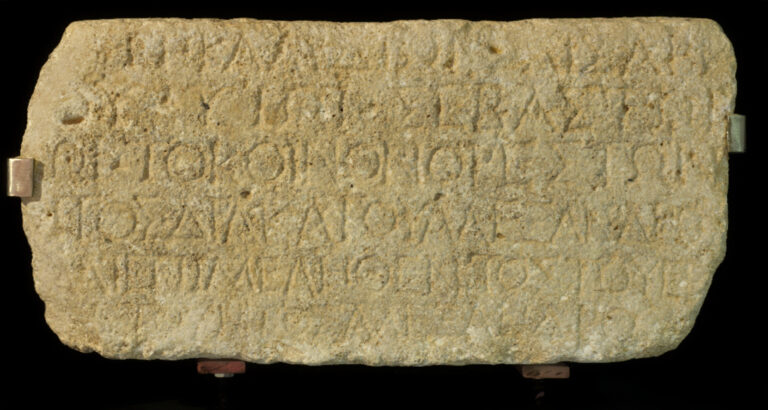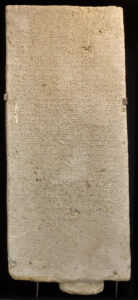Exhibits: section 3
Section 3
Stone inscription- Koinon of the Oresti
Partially preserved inscription, part of a honorary stone base. It is dated in the 1st century AD. and it was found in Argos Orestiko.
The importance of this inscription lies to the fact that it confirms the existence and the institutional role of the Koinon of the Oresti, as a collective and political body of Orestis. The inscription is synchronous to the reign of the emperor Claudius (41-54 AD). According to the inscription, the ‘Koinon’ erects a votive (possibly a statue) to the emperor and organizes games in his honor. Names of two officials are mentioned: the first, Drakas, son of Alexander, was perhaps the president of the assembly, and the second, Alexander, was the man responsible for the construction of the monument and the organization of the games. We do not know where this votive stood.
[ΑΥΤΟΚΡΑΤΟΡΙ]∙ΤΙ∙ΚΛΑΥΔΙΩΙ ΚΑΙΣΑΡΙ
[ΘΕΟΥ ΔΡΟΥΣ]ΟΥ∙ΥΙΩΙ∙ΣΕΒΑΣΤΩΙ
[ΓΕΡΜΑΝΙ]ΚΩΙ∙ΤΟ ΚΟΙΝΟΝ ΟΡΕΣΤΩΝ
------ΝΤΟΣ ΔΡΑΚΑ ΤΟΥ ΑΛΕΞΑΝΔΡΟΥ
[-------- Κ]ΑΙ ΕΠΙΜΕΛΗΘΕΝΤΟΣ ΤΟΥ ΕΡ-
[ΓΟΥ ΚΑΙ ΑΓΩΝΟ]ΘΕΤΟΥΝΤΟΣ ΑΛΕΞΑΝΔΡΟΥ
[ΤΟΥ ----------------------------]
Stone stele- the decree of the Battynaeans
Stone, parallelepiped with an engraved inscription at its main side, preserving the strut at its lower edge. It is dated in the 2nd c. AD. and it was found in Kranochori.
The inscription describes thoroughly the issue of a decree. The chairman analyses the problem and outlines his argument. Then, his proposal is unanimously approved, ratified and published – along with the names of all the citizens who voted in favour– in a public place where it can be read by everyone.
According to text, the politarch (= a civic magistrate) of the Battynaeans summons the local assembly (“ἐκκλησία”) following public complaints ‘with bitter lamentations’ (“πολλὰ ἀποδυρομένων”) about the occupation of communal land by ‘provincials’ (“ἐπαρχικούς”) – presumably settlers from the Province of Macedonia. Not only that, but the ‘more powerful of the provincials are driving the poor folk off the land’ (“οἱ δυνατότεροι τῶν ἐπαρχικῶν ἐκβιάζονται τοὺς πένητας”), closing it to grazing nor even allowing a right-of-way to other pastures. The politarch and the body of citizens ‘are of one mind’ (“ὁμογνωμοῦσιν”) in the matter, and vote unanimously to restrict the ‘provincials’ to the land allotted them by the property census of Gentian (ca. AD 118-120) and to rescind their right to ‘buy and occupy public land’ (“ἀγοράζειν ἢ κατέχειν δημοσίαν γῆν”). The politarch in office each year (“κατὰ ἔτος γεινόμενον πολειτάρχην”) is to be responsible for ensuring that the decree is enforced, and failure to do so will be punishable by a fine of ‘five thousands’ (“εἰς φίσκον δηνάρια πεντακισχείλια”) payable to the state and five thousand more to the commune. The decree, it then states, is to be taken to the Roman governor of the province, Junius Rufinus, by the three ambassadors ‘of the nation’ (“τοῦ ἔθνους”) of the Oresti for ratification. This done, the same ambassadors are to ensure that a copy is erected in the Agora in Battyna, where it should remain ‘in perpetuity’ (“εἰς τὸ διηνεκὲς μένειν κείμενον”). The text closes with the date on which the decree is passed – ‘the year 40 and 300 (ie. 192 AD), on the thirtieth day of the month of Artemisios’ – and the seal of the politarch, Alexander, son of Leonidas.

